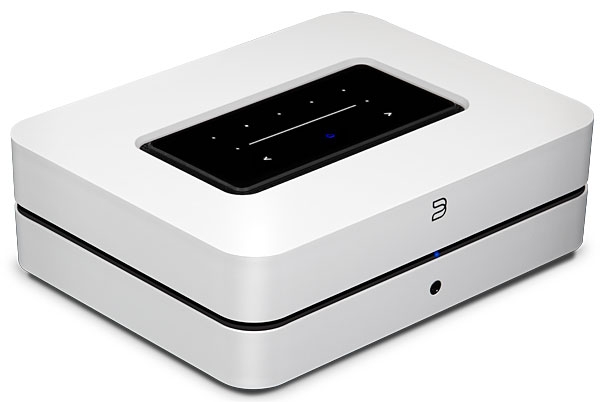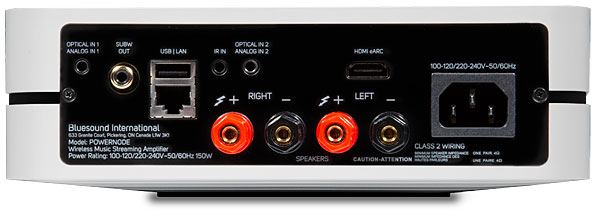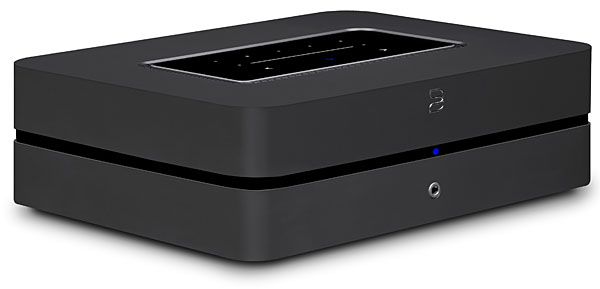| Columns Retired Columns & Blogs |
Bluesound PowerNode streaming integrated amplifier

Old-school audiophiles like me cling to our vinyl records and CDs. We spin them on turntables and slide them into transports, which send electric signals through wires to solid state or tubed amplifiers—a string of hardware devices. But, despite our object-attached ways, we're quite aware that we are living in a software-enabled, Bluetooth-connected, Wi-Fi–facilitated world. Even our Milky Way galaxy is wireless; as that pontificator of everything galactic, scientist Neil DeGrasse Tyson, has proclaimed, "We're all connected."
Footnote 1: Previous versions of the Node and Powernode had model-number designations; the most recent Node, for example, was the Node 2i. (I own one.) For the most recent model, Bluesound has dropped the model number but prefers to spell the product name in all caps: NODE and POWERNODE. We're doing that once. For the rest of the review, we'll use the usual conventions for proper nouns.—Jim Austin
"Connected," though, can mean different things. For some, it means stumbling down the street staring at a smartphone screen and bumping into strangers as life rushes by. For others, it's a way to carry their office wherever they go—a curse if you ask me. But for still others, including the multitude of music lovers who have purchased Bluesound's NODE streamer, POWERNODE streaming amplifier, and VAULT storage (footnote 1), it's a net positive: They can have music—a big fraction of all the music there is—almost anywhere they want.
Debuting in 2012, the Bluesound Node and Powernode have sold upward of a million units, a roaring success for parent company Lenbrook, which also owns and shares technology from PSB speakers and NAD, no strangers to high-value audio equipment. NAD, in fact, produced what might be the most iconic high-value amplification component ever made, the 3020 integrated amplifier, which launched in 1978 for $135. That's just under $600 in today's dollars.
One reason for the Powernode's success is its simplicity: Its rounded corners and compact design look fantastic. If you didn't already know it, you might not recognize this device, with its flickering proximity sensors that light up when you approach, for what it is. Maybe it's a headphone amp, or a small UFO ambassador from a high-end mothership. The Powernode's suedelike finish completes its cosmetic allure. Plus, operating it is child's play.
Probably the main reason for the Powernode's success is its extreme value: It's almost an all-in-one music system, lacking only speakers and speaker cables. And it costs just $899.
Design
Now in its fourth iteration, the Canadian-designed, Chinese-manufactured Powernode is rated at 80Wpc into 8 ohms, a 20Wpc increase from the previous (2i) generation. The Powernode's "HybridDigital" class-D power module is based on the Hypex UcD module. Though rated at 80Wpc into 8 ohms, the Powernode is said to be capable of instantaneous power delivery of up to 120W.
UcD, which stands for Universal Class D, "is a topology developed by Bruno Putzeys," Greg Stidsen, chief technology officer at Lenbrook International, told me in an email. "It's a self-oscillating analog amplifier that solves many of the problems inherent in previous class-D amplifiers. It has less noise, wider bandwidth, and is load-invariant (same frequency response into all speaker impedances). We use custom circuitry to control clipping, which provides greater stability and faster overload recovery. We call it HybridDigital to differentiate it from our DirectDigital class-D amplifier implementations, which are essentially DACs with enough output voltage to drive a speaker directly. In simple terms, a [DirectDigital] amplifier works with a digital PCM input whereas [HybridDigital] works with an analog input but uses switching modulation like a digital amp. Almost all the amplifiers in the NAD Classic range use a variation of this output stage."
The Powernode converts PCM data up to 24/192; computational tasks are handled by a quad-core 1.8GHz ARM Cortex-A53 processor, which replaces the single-core ARM Cortex-A9 processor used in the previous Powernode. Bluesound says it has eight times the processing power of the previous chip.
"This new generation processor has greater integration, and more memory, that allows for improved circuit layout and support for more advanced Wi-Fi radios," Stidsen stated. "With high-speed digital signals, the shorter ... the signal path, the better the time integrity, so smaller die sizes and greater integration improve performance. More memory and speed allow for more sophisticated DSP filters and snappier response when switching audio streams, most of which require unpacking (FLAC, MQA, Dolby, etc.)."

With its almost featureless 3"-high façade, the Powernode doesn't look like other audio components. A multicolored LED-lit logo indicates power status, and a 3.5mm jack allows you to connect a pair of wired headphones. The sleek, top-mounted control panel has five touch-sensitive LEDs. You can program these LEDs to play a favorite album, track, radio station, podcasts—anything the Powernode can play. Just touch a dot for immediate audio satisfaction. That's five presets; 35 more are available on the Bluesound Controller app. The top of the chassis also has a finger-controlled volume slider, which, when used, seemed to magically glide. There are also touch controls for pause, play, and track forward/back. The Powernode's back panel is equally minimalist. There's a USB Type-A port for attaching a storage device, an RJ45 Ethernet connector for streaming, two dual mini TosLink/3.5mm analog inputs (footnote 2), and a pair of standard five-way binding posts for connecting speakers. One very useful feature—pretty rare on a device intended for audio—is HDMI-ARC, which you can use to send sound to the Powernode from a video device, like a TV, AVR, or video projector.
There's also an RCA jack for a subwoofer; Bluesound's implementation of the sub output is simple and cool. Using the app's slider control under Settings, the amplifier's crossover frequency is adjustable between 40 and 200Hz.
The Powernode's BluOS streaming platform facilitates Tidal, Spotify Connect, Deezer, Amazon Music, Idagio, Apple, Qobuz, Bugs, Internetradio (TuneIn, Sirius XM), and Calm Radio; some of those I hadn't even heard of. It's Roon Ready and MQA-capable. AirPlay 2 is supported, as is two-way AptX HD Bluetooth (receive music from a portable device; send music out to Bluetooth headphones), plus Wireless Dolby surround sound. BluOS is a multiroom system, supporting up to 64 playback zones. Dual-band Wi-Fi is also supported, for connecting the control app and for soaking up streaming music data (although for streaming, a wired connection is always preferred). The Powernode can also send music wirelessly to BluOS-compatible speakers.
The Powernode supports voice control with Apple's Siri, Amazon's Alexa, and Google Voice. I've mentioned the BlueOS Controller app several times: It's free of course, on the iOS, Android, macOS, and Windows platforms.
What's missing? While there are two analog inputs for hooking up other sources—turntable, CD player, radio tuner—they're on 3.5mm headphone-type connectors, shared with mini-TosLink connections. There's no way to send data out to an external DAC—a feature that the regular Node has (although of course the Node lacks the Powernode's built-in amplification). None of this seems to have hindered the Powernode's popularity.
Setup
I unboxed the Powernode, plugged in the Ethernet cable, connected the speaker cables and the power connection, and loaded the BlueSound Controller app onto an iPad. For a graying gearhead used to crawling behind racks, this was a revelation, almost hard to believe. That's all I have to do? Yes, that's it! Let there be music! And so there was, in 10 minutes flat.

The downloadable quick start guide and manual together comprise six pages, their condensed contents reflecting the Powernode's ease of use. The manual explained the façade-mounted LED's "blink codes," including red "Powering up," solid green "Hotspot Mode," flashing green "Connecting to Network," and solid blue "Connected to Network." There was no explanation of how to use the app in either guide or manual, so I dove in headfirst.
I needn't have worried. The Controller app and BluOS were straightforward to use. I launched the app. It located the Powernode, which required a name. Accessing the menu/Navigator Drawer, I added Tidal and Qobuz from Music Services, entering my sign-in credentials. Tidal immediately showed my Playlists, Presets, Music, and Favorites, plus "Popular" and "Masters." HDMI, Radio Paradise, TuneIn, and Bluetooth were also available. (Radio Paradise is available in MQA—a BluOS exclusive.) Under Settings, I found bass and treble adjustment sliders (–6dB to 6dB), Subwoofer setup, Output Mode options (Stereo, Left, Right, Mono), and Volume Limits.
Roon spoils us with its detailed playback path and file resolution information, something we audiophiles care a lot about but apparently most others don't. In contrast, BluOS provided only basic information: "CD," which I assume means the file or stream being played is 16/44.1, or a squiggly sign for MQA, next to the song's countdown ticker.
BluOS, though, was easy to navigate, and I never saw an error message or experienced a glitch that left me music-less or frustrated. It simply worked, and worked simply, every time. The app let me traverse decades, genres, and musicians, making the transition between choices almost as quick as my thoughts.
Sound
Paired to one of the great values in hi-fi, the GoldenEar BRX standmount loudspeakers ($1600/pair), I was delighted with the sounds the Powernode produced. The amp struck a good balance of richness and crispness, scale and density. This level of musical goodness for $899 makes it a no-brainer of entry-level audiophile exceptionality, on par with NAD's classic 1970s-era 3020 integrated amp, which was about as omnipresent in music lovers' homes then as the Node and Powernode are today.
Footnote 1: Previous versions of the Node and Powernode had model-number designations; the most recent Node, for example, was the Node 2i. (I own one.) For the most recent model, Bluesound has dropped the model number but prefers to spell the product name in all caps: NODE and POWERNODE. We're doing that once. For the rest of the review, we'll use the usual conventions for proper nouns.—Jim Austin
Footnote 2: If you want to connect a phono stage, or any other analog input, you do it here with an RCA–3.5mm adapter.
- Log in or register to post comments




































